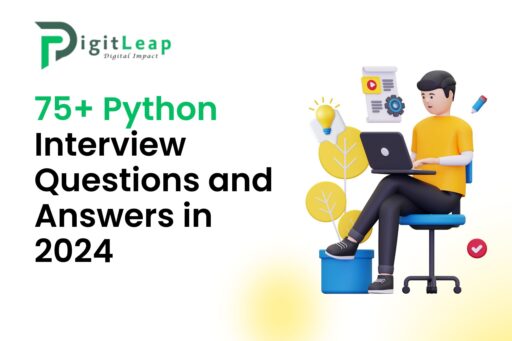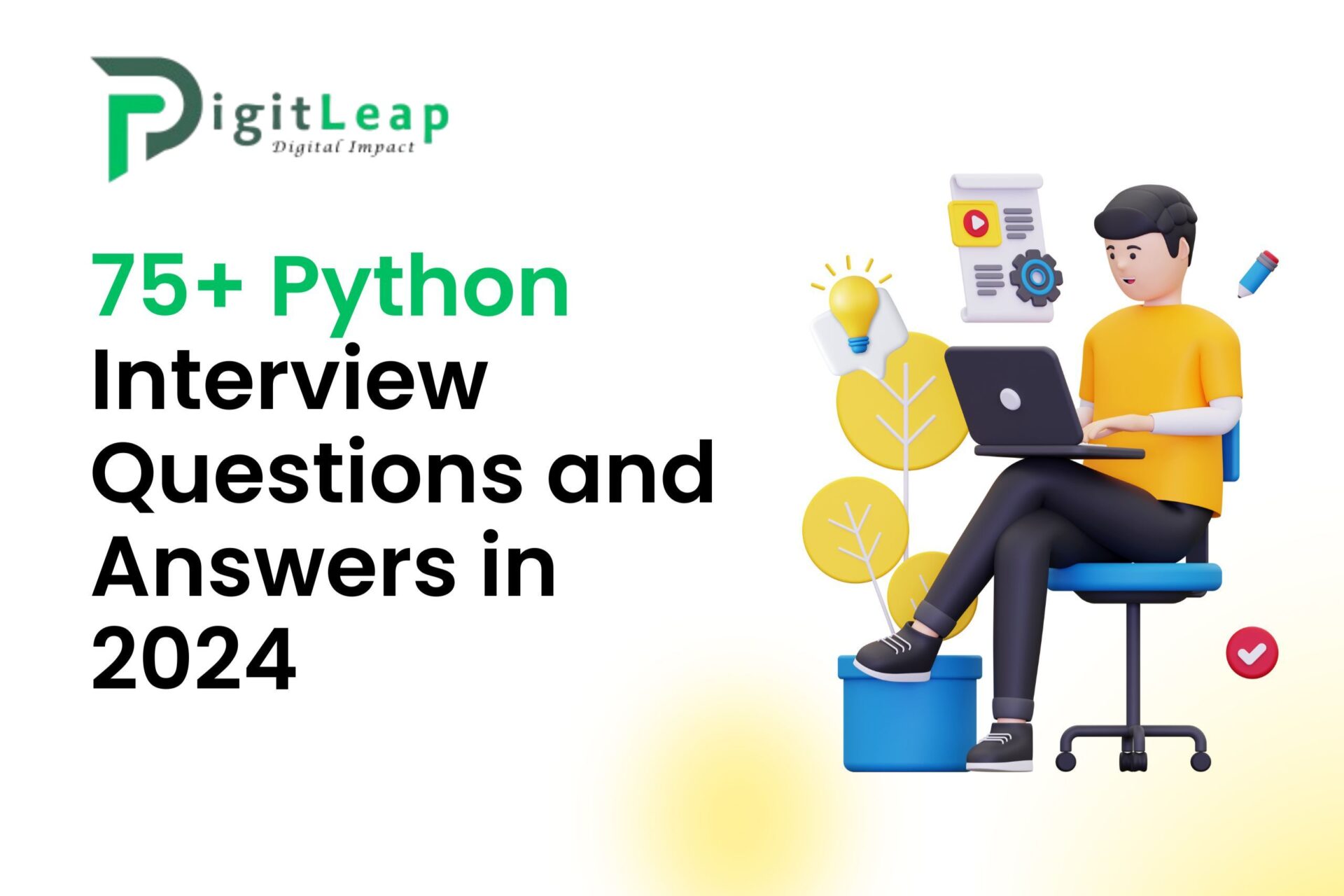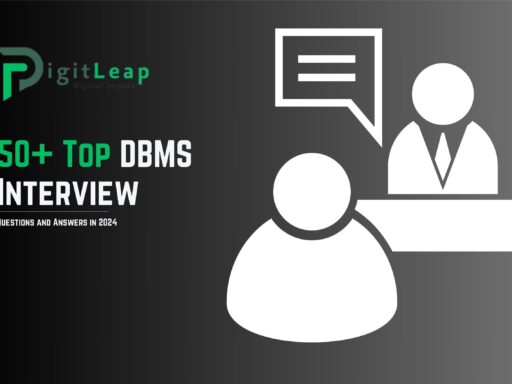75+ Python Interview Questions and Answers in 2024
- What is Python?
- Answer: Python is an interpreted, high-level, general-purpose programming language known for its readable syntax and dynamic typing. It supports various programming paradigms, including procedural, object-oriented, and functional programming.
- What are the key features of Python?
- Answer: Key features include easy syntax, interpreted language, dynamically typed, extensive standard library, supports multiple paradigms, cross-platform, and has a large community.
- What is PEP 8?
- Answer: PEP 8 is a style guide that provides coding conventions for Python code to improve readability and consistency.
- What are Python decorators?
- Answer: Decorators are special functions that modify the behavior of another function or method without changing its actual code.
- Explain the difference between
listandtuple.- Answer: Lists are mutable, and tuples are immutable. Lists use square brackets
[], and tuples use parentheses().
- Answer: Lists are mutable, and tuples are immutable. Lists use square brackets
- What is the difference between
append()andextend()methods in lists?- Answer:
append()adds a single element, whileextend()adds multiple elements from an iterable.
- Answer:
- How is memory managed in Python?
- Answer: Python manages memory using a private heap and garbage collection to clean up unreferenced objects.
- What is a Python
lambdafunction?- Answer: A
lambdafunction is an anonymous, single-expression function defined with thelambdakeyword.
- Answer: A
- What is the purpose of the
selfkeyword?- Answer:
selfrefers to the current instance of a class and allows access to its methods and attributes.
- Answer:
- Explain the use of the
withstatement in Python.- Answer: The
withstatement manages resources like file handling by automatically closing the resource after use.
- Answer: The
- What are Python modules and packages?
- Answer: Modules are single Python files, while packages are directories containing multiple modules and an
__init__.pyfile.
- Answer: Modules are single Python files, while packages are directories containing multiple modules and an
- What is list comprehension?
- Answer: List comprehension provides a concise way to create lists in a single line of code.
- What is a Python iterator?
- Answer: An iterator is an object that allows traversing through all elements of a collection one at a time using
next().
- Answer: An iterator is an object that allows traversing through all elements of a collection one at a time using
- What is the difference between
==andisin Python?- Answer:
==checks for value equality, whileischecks for identity (whether two references point to the same object).
- Answer:
- Explain the
__init__method in Python.- Answer:
__init__is a constructor method that initializes an object’s state when it is created.
- Answer:
- What are Python magic methods?
- Answer: Magic methods (or dunder methods) are special methods like
__init__,__str__, and__len__that enable operator overloading and other behaviors.
- Answer: Magic methods (or dunder methods) are special methods like
- How do you handle exceptions in Python?
- Answer: Exceptions are handled using
try,except,finally, andelseblocks.
- Answer: Exceptions are handled using
- What is the purpose of the
finallyblock?- Answer: The
finallyblock executes code regardless of whether an exception is raised, commonly used for cleanup tasks.
- Answer: The
- What is the difference between
break,continue, andpassstatements?- Answer:
break: Terminates the nearest loop.continue: Skips the current iteration and continues with the next.pass: Does nothing; it’s a placeholder.
- Answer:
- Explain Python’s
@staticmethodand@classmethoddecorators.- Answer:
@staticmethod: Defines a method without access to the class instance or state.@classmethod: Defines a method that accesses the class state viacls.
- Answer:
- What is the Global Interpreter Lock (GIL)?
- Answer: The GIL is a mutex that prevents multiple native threads from executing Python bytecodes simultaneously.
- How can you achieve multithreading in Python?
- Answer: Use the
threadingmodule, but true parallelism is limited due to the GIL. Use multiprocessing for parallelism.
- Answer: Use the
- What is the difference between
deepcopyandcopy?- Answer:
copy: Creates a shallow copy of an object.deepcopy: Creates a deep copy, duplicating all objects recursively.
- Answer:
- What are Python metaclasses?
- Answer: A metaclass is the class of a class, defining how classes behave.
- What is the difference between
range()andxrange()?- Answer:
range(): Generates a list (Python 3.x).xrange(): Generates an iterator (Python 2.x).
- Answer:
- What is monkey patching in Python?
- Answer: Monkey patching is dynamically modifying a module or class at runtime.
- What is the
yieldkeyword?- Answer:
yieldis used in a function to make it a generator, returning values one at a time and saving the function’s state.
- Answer:
- What are Python generators?
- Answer: Generators are functions that yield values one at a time, preserving function state between calls.
- Explain the difference between multiprocessing and multithreading.
- Answer:
- Multiprocessing uses separate processes, achieving true parallelism.
- Multithreading uses threads within a single process, limited by the GIL.
- Answer:
- What is
__slots__?- Answer:
__slots__limits the attributes of a class, saving memory by not creating a__dict__for each instance.
- Answer:
- What are Python data structures?
- Answer: Python data structures include lists, dictionaries, sets, tuples, and abstract data types like stacks and queues.
- How does the
setdata structure work?- Answer: A
setis an unordered collection of unique elements supporting set operations like union, intersection, and difference.
- Answer: A
- Explain the difference between
dictandOrderedDict.- Answer:
dict: Does not maintain order in Python versions before 3.7.OrderedDict: Maintains insertion order.
- Answer:
- How is a
dequedifferent from a list?- Answer: A
dequesupports fast appends and pops from both ends, unlike lists, which are slower at the start.
- Answer: A
- What are namedtuples in Python?
- Answer:
namedtupleis a tuple subclass that provides named fields for better readability.
- Answer:
- Explain how to use Python’s
heapqmodule.- Answer: The
heapqmodule provides heap queue algorithms for implementing min-heaps.
- Answer: The
- What is the difference between arrays and lists in Python?
- Answer: Arrays require homogeneous elements, while lists can hold elements of any type.
- How can you remove duplicates from a list?
- Answer: Use
set()or list comprehensions likelist(dict.fromkeys(list))to remove duplicates.
- Answer: Use
- What is a Python heap?
- Answer: A heap is a specialized tree-based data structure that satisfies the heap property, where each parent node is ordered according to a specific order.
- Explain how you can reverse a string in Python.
- Answer: Use slicing:
string[::-1]or thereversed()function.
- Answer: Use slicing:
- What is the
passstatement in Python?- Answer:
passis a null operation used as a placeholder when no action is required.
- Answer:
- How can you swap two variables in Python?
- Answer: Use tuple unpacking:
a, b = b, a.
- Answer: Use tuple unpacking:
- Explain how to handle missing keys in a dictionary.
- Answer: Use
dict.get(key)to returnNoneinstead of raising aKeyError.
- Answer: Use
- What is the
defaultdictclass?- Answer:
defaultdictis a subclass ofdictthat provides a default value for missing keys.
- Answer:
- What is the
Counterclass in Python?- Answer:
Counteris a subclass ofdictfor counting hashable objects.
- Answer:
- How can you sort a list in Python?
- Answer: Use
list.sort()for in-place sorting orsorted()for a new sorted list.
- Answer: Use
- What is the purpose of the
enumerate()function?- Answer:
enumerate()adds a counter to an iterable, returning index-value pairs.
- Answer:
- How do you read and write files in Python?
- Answer: Use
open()with modes like'r','w', or'a'for reading, writing, or appending.
- Answer: Use
- What are Python docstrings?
- Answer: Docstrings are string literals used to document modules, classes, methods, and functions.
- How do you convert data types in Python?
- Answer: Use functions like
int(),str(),float(), andlist()for type conversion.
- Answer: Use functions like
Advanced Python Interview Questions
- What is the
property()function?- Answer:
property()is used to manage class attributes with getter, setter, and deleter methods.
- Answer:
- Explain Python’s
map()function.- Answer:
map()applies a given function to each item in an iterable, returning a map object.
- Answer:
- What is the difference between
filter()andmap()?- Answer:
filter()returns items from an iterable that satisfy a condition, whilemap()applies a function to all items.
- Answer:
- How does the
zip()function work?- Answer:
zip()combines elements from multiple iterables into tuples.
- Answer:
- What are Python descriptors?
- Answer: Descriptors are objects that define how attribute access is managed through
__get__(),__set__(), and__delete__()methods.
- Answer: Descriptors are objects that define how attribute access is managed through
- What is monkey patching in Python?
- Answer: Dynamically modifying a class or module at runtime.
- How to perform unit testing in Python?
- Answer: Use the
unittestmodule to define and run tests.
- Answer: Use the
- What are Python coroutines?
- Answer: Coroutines are functions that can pause and resume execution using
await, primarily used for asynchronous programming.
- Answer: Coroutines are functions that can pause and resume execution using
- Explain how you can make a script executable.
- Answer: Add
#!/usr/bin/env python3at the top and give execute permissions usingchmod +x.
- Answer: Add
- What is Python’s Global Interpreter Lock (GIL)?
- Answer: GIL is a mutex that restricts execution to one thread at a time, limiting multithreading performance.
- Explain what
__name__ == "__main__"means.- Answer: It checks if the script is run directly or imported as a module.
- What is the
collectionsmodule?- Answer: The
collectionsmodule offers specialized data structures likedeque,Counter, andOrderedDict.
- Answer: The
- How do you implement singleton classes in Python?
- Answer: Use the
__new__()method or decorators to ensure only one instance.
- Answer: Use the
- What are context managers in Python?
- Answer: Context managers manage resource allocation, commonly used with the
withstatement.
- Answer: Context managers manage resource allocation, commonly used with the
- Explain the difference between
__str__()and__repr__().- Answer:
__str__()is for end-user readable representation, while__repr__()is for debugging/developer representation.
- Answer:
- What are Python magic (dunder) methods?
- Answer: Special methods with double underscores (
__init__,__add__) that define object behavior for operators and functions.
- Answer: Special methods with double underscores (
- Explain how to create a virtual environment in Python.
- Answer: Use
python -m venv <env_name>to create an isolated environment.
- Answer: Use
- How to handle JSON data in Python?
- Answer: Use the
jsonmodule withjson.load(),json.dump(),json.loads(), andjson.dumps().
- Answer: Use the
- What is
argparseused for?- Answer:
argparseis used for creating command-line interfaces by parsing arguments passed to the script.
- Answer:
- Explain the
asynciomodule.- Answer:
asynciois used for asynchronous programming, managing coroutines, tasks, and events.
- Answer:
- What is a weak reference in Python?
- Answer: Weak references allow the referenced object to be garbage collected, used to avoid memory leaks.
- How to secure Python code from SQL injection?
- Answer: Use parameterized queries or ORM libraries like SQLAlchemy.
- What is the
picklemodule?- Answer:
pickleserializes Python objects to a byte stream and deserializes them back.
- Answer:
- Explain the difference between shallow and deep copy.
- Answer: Shallow copy duplicates the structure, while deep copy duplicates both structure and data recursively.
- What is an abstract base class (ABC)?
- Answer: ABCs define a blueprint for derived classes, enforced through the
abcmodule.
- Answer: ABCs define a blueprint for derived classes, enforced through the
This guide provides a wide range of Python interview questions, covering everything from basics to advanced topics. Let me know if you need a specific section or additional details!
Other Important Q&A List :
- OOPs Interview Questions And Answers
- SQL Interview Questions and Answers
- Content Writing Interview Questions and Answers
- Email Marketing Interview Questions and Answers
- Django Interview Questions and Answers
- C Programming Interview Questions and Answers
- ReactJS Interview Questions and Answers
- Angular Interview Questions and Answers
- Power BI Interview Questions and Answers
- Top DBMS Interview Questions and Answers
- Python Interview Questions and Answers
- MySQL Interview Questions and Answers
- Java Interview Questions and Answers
- Data Structures Interview Questions
- Flutter Interview Questions and Answers
- JavaScript Interview Questions and Answers
- PHP Interview Questions and Answers
- CSS Interview Questions and Answers
- HTML Interview Questions and Answers






